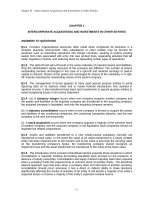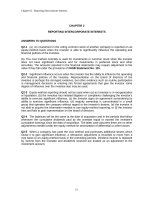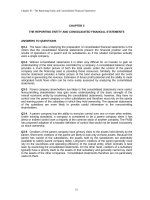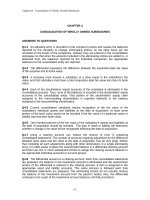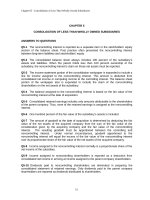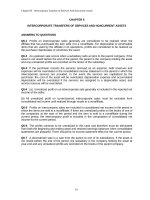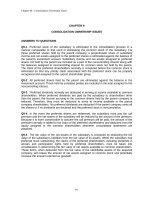Solution manual for intermediate accounting 6th edition by spiceland
Bạn đang xem bản rút gọn của tài liệu. Xem và tải ngay bản đầy đủ của tài liệu tại đây (159.52 KB, 3 trang )
Full file at />
Chapter 1
Environment and Theoretical Structure of
Financial Accounting
EXERCISES
Exercise 1-1Requirement 1
Haskins and Price
Operating Cash Flow
Cash collected
Cash disbursements:
Payment of rent
Salaries
Travel
Utilities
Net operating cash flow
Year 1
$330,000
Year 2
$450,000
(60,000)
(200,000)
(50,000)
(30,000)
$(10,000)
-0(210,000)
(60,000)
(50,000
$130,000
Requirement 2
Haskins and Price
Income Statements
Revenues
Expenses:
Salaries
Utilities
Travel
Rent
Net Income
Year 1
$380,000
Year 2
$440,000
(200,000)
(40,000)
(50,000)
(30,000)
$ 60,000
(210,000)
(40,000)
(60,000)
(30,000)
$100,000
Requirement 3
Year 1: Amounts billed to customers
Less: Cash collected
Ending accounts receivable
$380,000
(330,000)
$ 50,000
buy this full document at
Year 2: Beginning accounts receivable
Plus: Amounts billed to customers
Less: Cash collected
Ending accounts receivable
Exercise 1-2
g
List A
1. predictive value
h _2. relevance
e
3. Faithful representation
j
c
4. comprehensive income
5. materiality
a _6. consistency
i
7. verifiability
b
f
8. matching principle
9. historical cost principle
d 10. realization principle
© The McGraw-Hill Companies, Inc., 2011
1-2
$ 50,000
440,000
$490,000
(450,000)
$ 40,000
List B
a. applying the same accounting practices
over time
b. record expenses in the period the related
revenue is recognized
c. concerns the relative size of an item and its
effect on decisions
d. concerns the recognition of revenue
e. along with relevance, a primary decisionspecific quality
f. the original transaction value upon
acquisition
g. information is useful in predicting the
future
h. pertinent to the decision at hand
i. implies consensus among different
measurers
j. the change in equity from nonowner
transactions
Intermediate Accounting, 6/e
Full file at />
Exercise 1-3
2.
3.
4.
5.
6.
1. The periodicity assumption
The matching principle
The historical cost (original transaction value) principle
The full disclosure principle
The realization (revenue recognition) principle
The economic entity assumption
1. The periodicity assumption
Exercise 1-4
2.
3.
4.
5.
6.
The historical cost (original transaction value) principle
The matching principle
The full disclosure principle
The economic entity assumption
The realization (revenue recognition) principle
buy this full document at

